Making your own learning games and resources does not need to be a parent only activity. Infusing the children into the process will not only teach the reward of hard work and the sense of pride that comes with completing a job well done, but can double as an academic and vocational exercise, as well.
I can nearly guarantee you the kiddos will have so much fun working on such projects that they will not even realize they are elbows-deep in an educational activity.
You do not need to be a homeschooling parent to benefit from these DIY learning games and activities. You can engage in the making and use of these projects as part of your general child rearing and family fun activities – or homesteading training.
As a homesteader, I work diligently to infuse self-reliance skills into every academic learning lesson when working with both our homeschooled and non-homeschooled grandchildren of all ages.
Not only do we make educational games and activities together with the children as part of their educational routine, but we create toys together, as well. Yes, toy making can be a huge learning opportunity.
Even if your children are too old to play with any of the toy projects featured in this article or that you are inspired to make on your own, he or she can give them as gifts to loved ones, friends, or donate them to charitable organizations.
Learning Skills Developed From Game, Activity, and Toy-Making
- Comprehension
- Responsibility
- Following Multiple Step Directions
- Measurement
- Math
- Reading
- Tool Use
- Science – when making projects that deal with mixing of ingredients, animals, levers, etc.
- Social Studies – when making period based reading extensions games, activities, and toys
- Hand Eye Coordination
- Teamwork
- Leadership
- Colors And Shapes
- Art
- Physical Education
- Prediction Making
- Hypothesis Formation
- Sequencing
In addition to these defined educational and vocational skills, children also can flex their ingenuity and creativity skills, learn to adapt and overcome when faced with obstacles in completing the project, learn patience, be introduced to basic homesteading skills. and diligence from seeing a project through from start to finish.
One of my favorite learning skills developed when making learning toys, games, and activities is the honing of the decision making process.
The children are given directions to follow for the project, but they alone should be left to decide on material selection, eye color, hair color, clothing or fur materials, etc.
This might sound like a little thing, but as a former public school instructor, I can guarantee you it is not.
Our children are force-fed all day long every day in most government run schools. They are told how to do something down to the tiniest of detail. This cripples not only their imagination, but the ability to think for themselves and the ability to make even a seemingly small decision.
Learning how to make a good decision, adapt from making a bad one, and living with the results of a decision is a life skill that needs to be cultivated from a very young age.
These games, activities, and toys can serve as a learning resource as stand alone projects, or be engaged in specifically as extension activities to go along with academic text or living books they are reading.
Most of us of a certain age, can remember way back when doing school projects on a regular basis was commonplace and spending long days sitting in a chair practicing for standardized tests, was not.
Making projects with the children or offering them guidance to work independently on them will be reminiscent of making dioramas in elementary school, just on a grander scale.
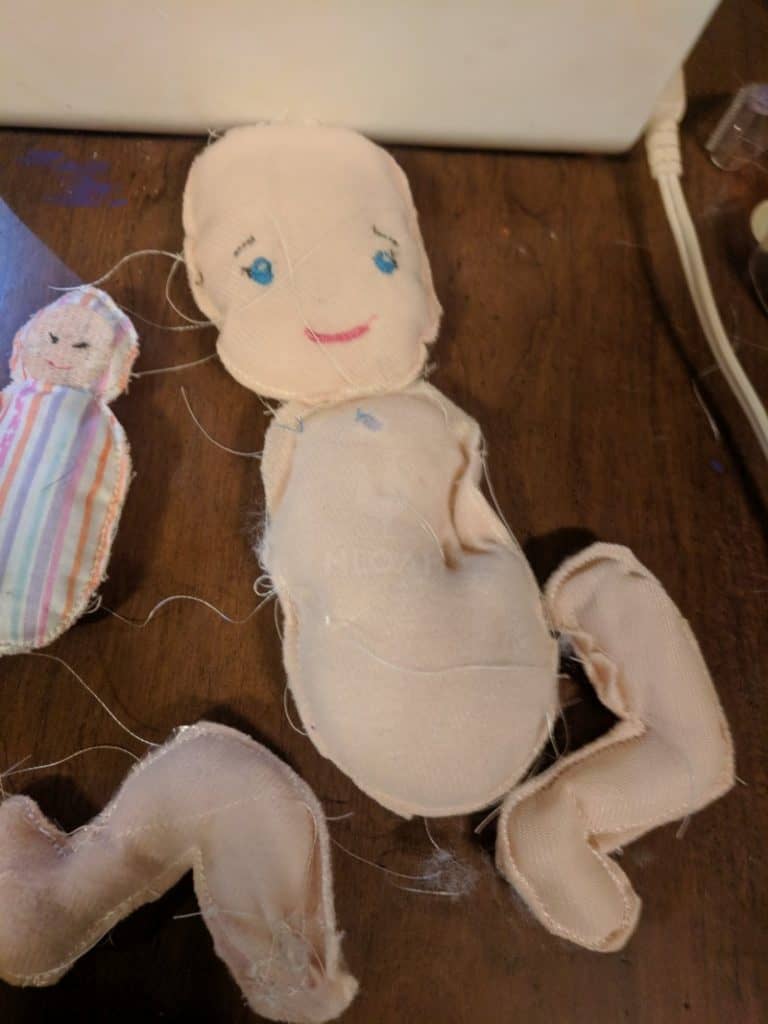
1. Homemade Dolls
Dollmaking might not appeal to boys at first, but when you alter the concept a bit, to include super heroes, historical figures, or favorite characters – even dragons or other animals, they will warm to the idea.
Waldorf dolls or any type of traditional cloth doll or stuffed animal offers a plethora of learning opportunities.
Cloth Doll Learning Concepts
- Selection of materials – Decision making and critical thinking
- Using tools both safely and wisely – Tool Use
- Measuring fabric – measurement
- Cutting fabric – hand eye coordination and math: pattern piece count
- Pattern usage – Comprehension – following multiple step directions
- Sewing – hand eye coordination if hand sewing or tool uses if machine sewing
- Embroidering facial features – tool use – hand eye coordination – art
- Gluing or attaching on embellishments – art – hand eye coordination – tool use
Project Cost
The cost of making this project will depend on the number and size of dolls being made. If you already sew, scraps left from other projects could be used to make clothes and accessories for the dolls.
Check out the New Life On A Homestead Waldorf Doll Making tutorial to garner free patterns for a variety of sizes of cloth dolls, directions, and free clothing patterns, as well.
If you keep sheep, an abundance of natural and free stuffing material abounds. Check these links out to learn more about how to process and naturally dye wool for craft projects.
To make the doll’s “skin” you can use flesh toned felt, painter’s canvas, scrap cotton shirt material in flesh tones, or purchase what is commonly dubbed “doll flesh” fabric from a craft store or Amazon.
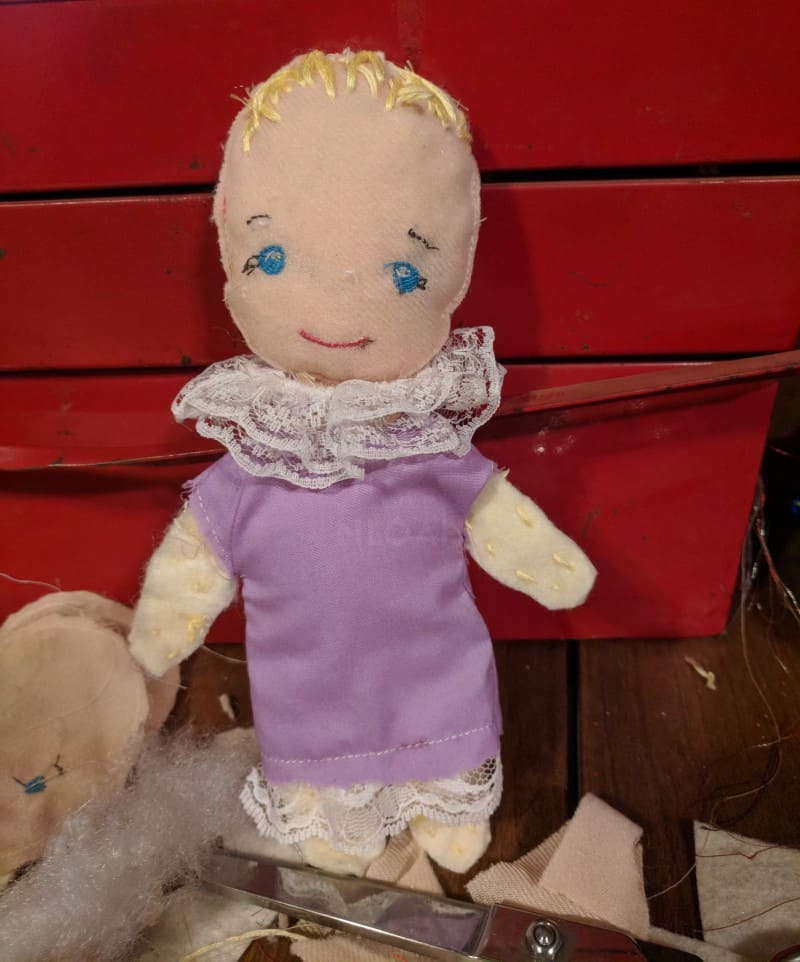
Project Enhancements
Making cloth dolls is a great tie in to a social studies lesson. You could make dolls or even hand puppets that relate to the lesson and allow the children to use them to re-tell the story as a part of a comprehension or oral presentation activity.
If using the dolls in this manner, consider getting some poster board to allow the children to also make a backdrop for their storytelling that depicts a scene or scenes from their story.
Making a simple stage or puppet show booth out of scrap plywood or particle board could be another superb project for the children to help complete.
I recommend painting a basic scene on a permanent backdrop, perhaps an interior setting on one side of the board and an exterior setting on the other side that can be adorned with temporarily attached small details the children make or help make for specific living books or textbook lessons.
Gluing velcro around each setting creates an easily attachable and detachable feature to detailed adornments the children make out of paper, felt, or cardboard that are also velcro backed.
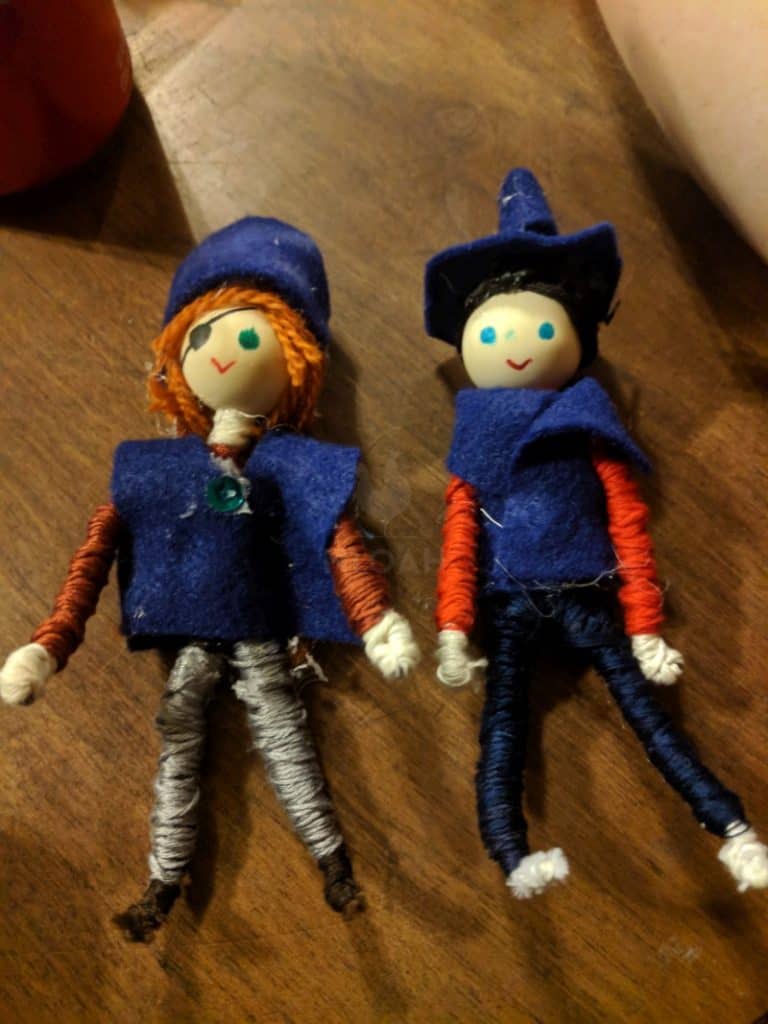
2. Story Extension Bendable Dolls
These homemade dolls have more of an action figure type of body and are dollhouse size. They require a lot less time and money to make than a stuffed cloth doll.
These story extension bendable dolls can be made in a single hour instead of over the course of a full day or sometimes several days.
Bendable Doll Learning Concepts
- Cutting felt or scrap fabric – math, art, and hand eye coordination
- Material selection – Decision making
- Following directions – comprehension
- Safe tools use – Responsibility and tool use
- Fabric measurement – measurement
- Drawing Facial Features – Hand eye coordination, colors, and art
- Sewing or gluing clothing – hand eye coordination
- Gluing on hair and embellishments – hand eye coordination, art, and tool use
- Critical Thinking
Project Cost
Again, the amount of money that will be needed to make these dolls will depend on the scrap materials you have on hand and the number of dolls being made.
If you purchase the pipe cleaners at a Dollar Tree or similar store, and already have fabric or felt scraps for clothing and either embroidery floss or yarn for wrapping the bodies, the only cost involved would be buying some wood beads to make the heads – which is extremely nominal.
If you do have to purchase felt, the basic craft felt squares typically sell for $.15 to $.55 each and you could make four sets – or more, of doll clothes out of a single piece.
To learn how to make Waldorf dollhouse style bendable dolls, check out my tutorial here. If you enjoy sewing and want to use a making a folding fabric dollhouse into a learning activity while giving the new dolls a home at the same time, check out this tutorial. The same concept can be used to make a barn, action figure headquarters, etc.
These dolls could also be used for story re-telling learning activities. They could also be used for color sorting or pattern sequencing if you design or adorn their clothing in a corresponding manner.
Because making the dolls themselves is a fun learning adventure, the children could just simply enjoy the sense of accomplishment that comes from making something yourself and play with their doll, pirate, knight, fairy, etc. or give them as a gift.
I am sure that any grandmother would love to have a shelf sitter doll or one with a magnetic glued to the back that was made by a grandchild to display.
A homemade set of dolls or bendable figures would make wonderful homemade birthday or Christmas gifts to be given as a complete set or in a kit with directions.
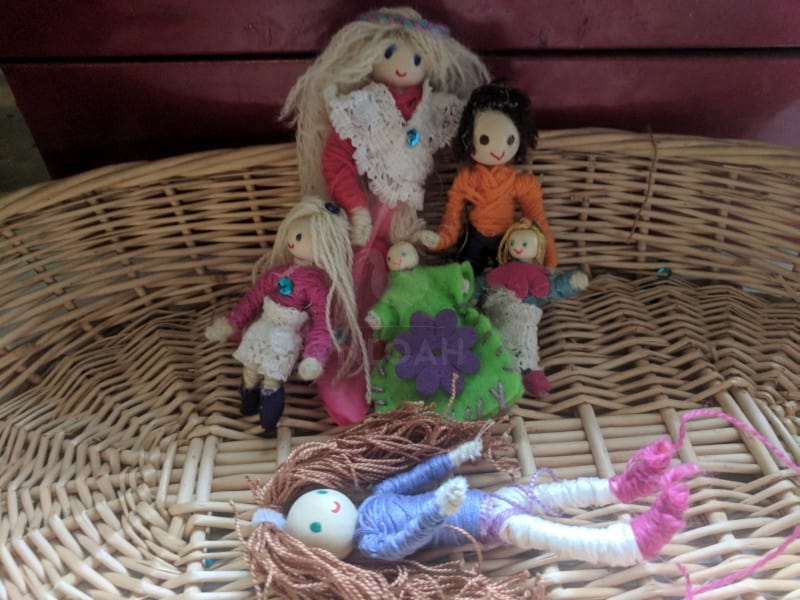
3. Needle Felted Scenery and Animals
Children can create amazing dioramas, story scene creatures and embellishments, and “stuffed” animals from wool harvested on the homestead or purchased. If you are following a Waldorf or Charlotte Mason inspired toy collection or homeschool protocol, learning how to needle with or for your children will be a massive money saver.
Needle felting needles are sharp – very sharp. After a safety lesson I allow my three and a half and four and a half year old grandchildren to needle felt under my supervision.
The oldest poked his finger once before he forgot to keep the wool being felted on the sponge work space and neither he nor his sister ever made that mistake again.
Needle Felted Scenery and Animals Learning Concepts
- Needle felting tools – responsible and safe tool use
- Animal Parts – Shapes, colors, patterns, and measurement
- Animal habitat play mat – science, comprehension, following directions, measurement
- Needle Felting – hand eye coordination, art, following directions
- Critical Thinking
- Comprehension
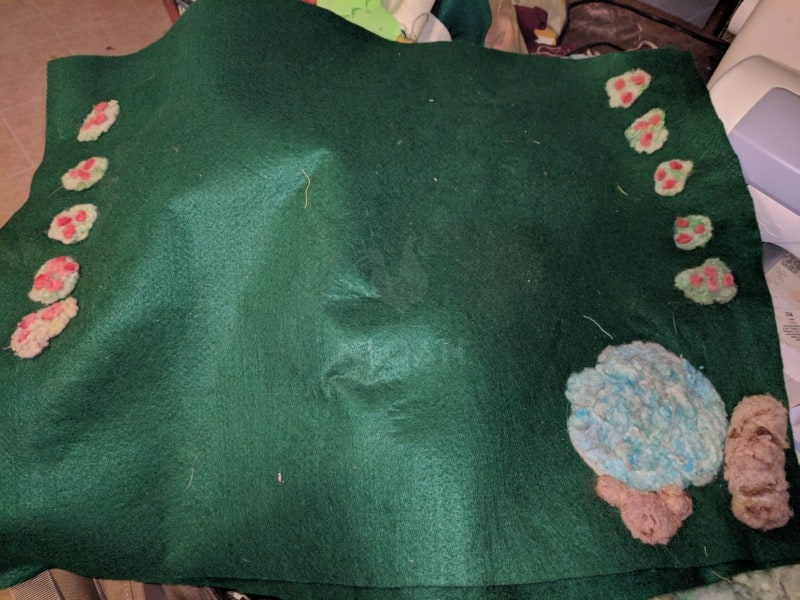
Project Cost
If you have your own wool, that will be a major cost saver on this project. If you must purchase wool, it can be bought by the bag in white and dyed at home – keeping costs down and increasing the learning opportunities associated with this project.
You can also purchase carded wool in a single color or in color variety packs. The needles for felting can be purchased in large set – they break after steady use, for approximately $7 for a set of 15 on Amazon or at craft supply stores.
A Waldorf style play mat can run between $85 for a small one to up to $200 for a large one with lots of detail features like rocks, flowers, a pond, etc. Purchasing two yards of wool felt for less than $20 from a craft store and needle felting the mat yourself will offer substantial cost savings.
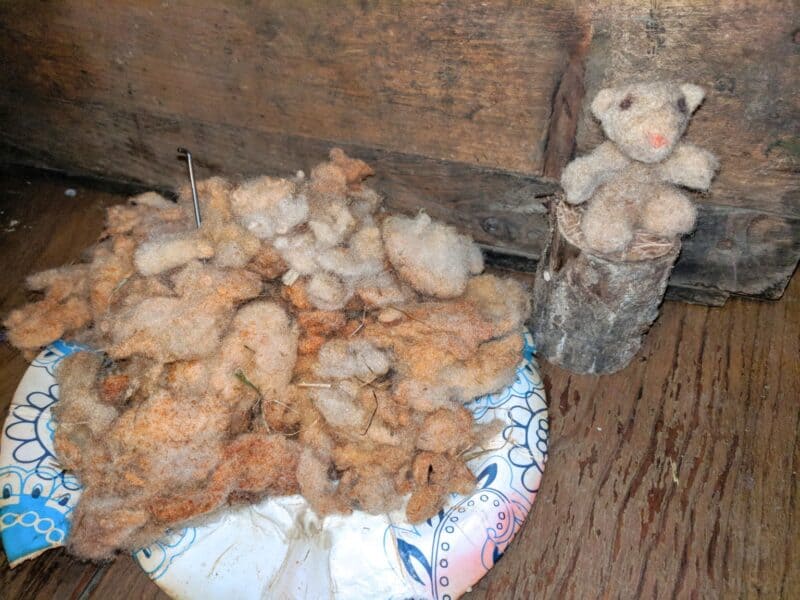
To learn how to needle felt, check out my tutorial here. Needle felting will require the child (and the adult) to exercise a lot of patience. It can take at least three hours to complete a single basic animal – hence why artisans charge $50 to $150 for their needle felted animals and dolls.
Needle felted play mats and animals can be used for story retelling comprehension activities, to make science dioramas, and be made available to the children to use when creating oral book reports in a bag lessons.
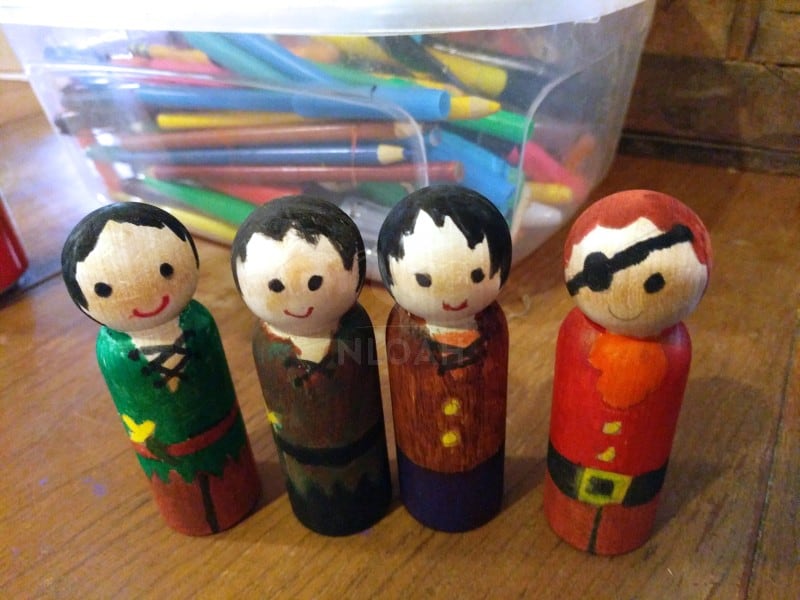
4. Wood Peg Dolls
These wood peg dolls are a favorite of all the little ones who come to our homestead to do learning projects – or receive them as gifts. There is very little work that goes into making wood pegs dolls, unless you have a lathe and use it to make your own.
The designs drawn onto the dolls can take as little as five minutes or 60, depending upon the amount of detail you want to embellish them with. I make my own organic wood stain or food grade paint so the dolls can be given or used by infants. Wood makes a far better teething toy than plastic or rubber junk that ships from China, in my personal opinion.
Wood Peg Dolls Learning Concepts
- Decorating the wood pegs – art, following directions, hand eye coordination.
- Critical Thinking
- Comprehension
The learning concepts honed during the actual project making is scant, it is how you use the wood peg dolls that creates the learning adventure.
How to Use Wood Pegs Dolls as Educational Resources
- As diorama figures
- As story retelling, oral book report, or book report in a bag manipulatives.
- Paint or stamp a different number on each wood peg doll and use for counting practice and math games.
- Paint a different lower or upper case letter on each doll and use them for alphabetical order practice or upper and lowercase letter matching activity.
- Draw a distinct design on the body of each wood peg doll and use them with homemade pattern sequencing flashcards to practice matching and extending a pattern sequence.
- Paint a matching color and or shape designs on the wood peg dolls for little ones to match.
- Paint or draw a distinct color or shape on just the bottom of the wood peg dolls and use them like a memory match game when they are all placed on a table. You can take this concept one step further, and make a wood base for the dolls to be placed in drilled holes as a type of game board.
- Buy wood peg dolls in different sizes so young children can put them in order by size.
- Use different sized wood peg dolls and a game board like noted above with different sized holes – some that do not fit any of the dolls, for toddlers and preschoolers to sort.
- As game pieces for a homemade board game.
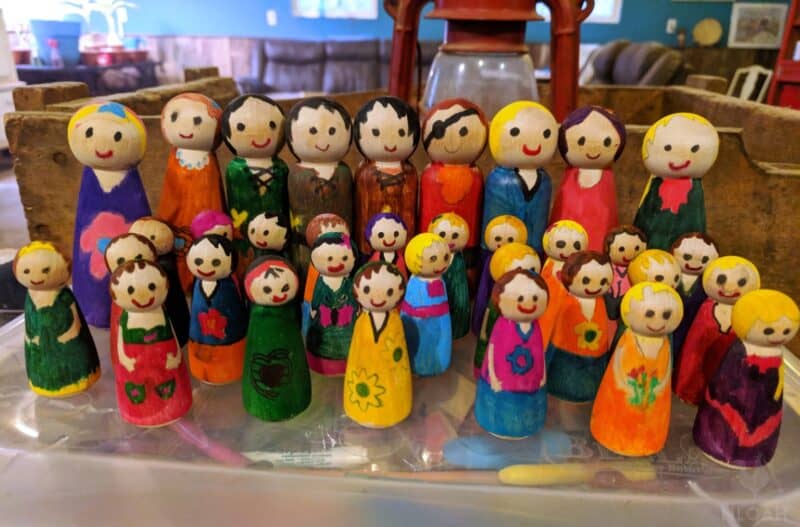
Project Cost
The wood peg dolls can be purchased from Amazon in small to large sets in various sizes that range in price from just a couple of dollars to $100 for enormous sets.
Artisans sell amazingly detailed wood peg dolls on craft websites like ETSY for $10 to sometimes as much as $50 each.
The only other cost you would have when making wood peg dolls would be the paint and or markers you choose to use.
Some folks make simple cloaks or dresses out of felt scraps or add yarn hair to their wood peg dolls. You can get as simple or as fancy as you like…
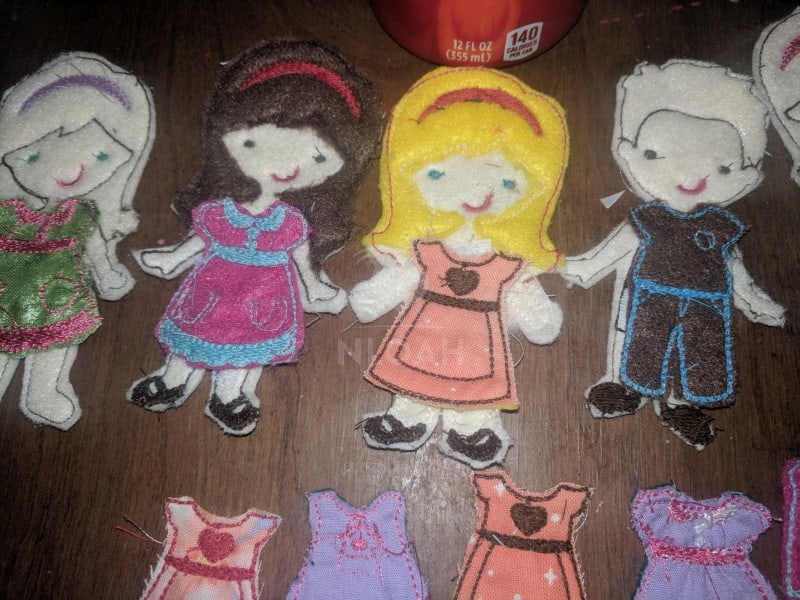
5. Felt “Paper” Dolls
I made the dolls in the photo using a digital embroidery design and my Brother embroidery machine. You can make the same dolls simply cutting the doll shape out of felt and embroidering, painting, or using markers to make the face. An abundance of free or low cost patterns for felt paper dolls exist online -especially on Pinterest.
Felt Paper Doll Learning Concepts
- Cutting felt pattern – hand eye coordination
- Following a pattern – comprehension and following directions
- Making felt paper doll clothes – art, hand eye coordination, following directions.
Like with the wood peg dolls, the primary educational value of this project comes from how the dolls are used.
- As felt or flannel board storytelling pieces.
- As color, shape, and pattern sorting manipulatives when the clothing on the doll is designed for such activities.
- As diorama figures.
- As book report manipulatives.
- For community helpers or historic figures in conjunction with early social studies and history lessons.
Project Cost
The purchase of a digital embroidery pattern typically ranges from $5 to $10, depending upon the number of doll styles and clothing options in the set.
You can also buy felt already cut into doll body shapes in various skin tones to use as a pattern to cut more from or to use them as the dolls themselves for less than $5 for about one dozen, I typically double or triple layer the felt to make the dolls more still.
You will need velcro hot glued or sewn onto the doll’s body like a bodysuit and a corresponding dot or square piece of velcro on each outfit so it sticks firmly. It will stick fine without the velcro on the back of the outfit but might not stand up to hardy play.
6. Wood Village
This is probably the most massive learning project to tackle on this list. Although little ones will need help with the power drill that must be used, they can still be deeply involved in the educational construction process of their new scene setting learning table or Waldorf style village.
The time spent hiking around your homestead to find the right branches and wood log rounds to use for this project is an educational journey in itself. During the hunt you can help the children learn the difference between soft and hardwood, and what each type is best used for both indoors and out.
The children should do a lesson about the trees that will be used prior to their scavenger hunt for materials, including leaf identification and what the tree produces: i.e. syrup, nuts, etc. Consider doing a back rubbing and a leaf collection journal as a part of the wood village construction project.
Wood Village Construction Project Learning Concepts
- Materials Search – nature science
- Measurement
- Manual and power tool use
- Following directions
- Math
- Comprehension
- Teamwork
- Science
Project Cost
The wood from your homestead used to make the Waldorf style wood treehouse a nearly free learning project. We used some wood thread spools to make a pulley system, some twine to make a zipline, some cardboard and more twine to make a few swings, and some thin branches cut in half to make levers and manual rotating bridges.
The table the Waldorf wood treehouse is sitting upon was made of scrap particle board and wood from our homestead “junk” pile. The children and I painted the table top to look like grass and a winding stream for added visual interest.
If you purchased this style of wood treehouse from a store that specializes in Waldorf toys or an artisan website like ETSY, it would cost in excess of $200.
From the scrap pieces of small branch rounds we cut to makes steps we created a wood memory matching game using ink stamps.
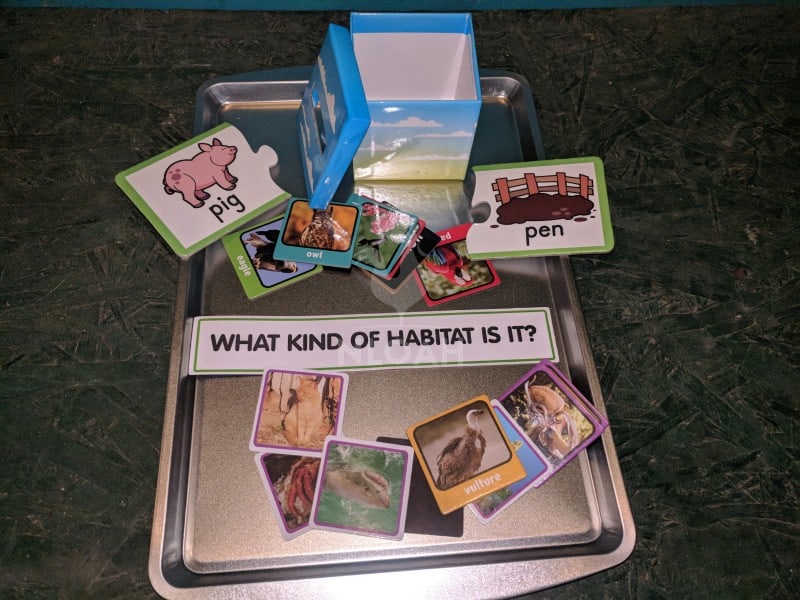
7. Sorting Games
Some folks think that sorting games are just for younger children, but they can be made to suit the mental challenge levels of older ones, as well.
Sometimes, the ideas for DIY learning games come from items you see in a store or have purchased. Adapting a store bought item to be used as a model to make a similar activity on a different topic, can happen fairly often.
That is exactly how I came up with the ideas for the sorting games in this section. The sorting games you will see in the feature video below are not handmade – not yet, but new differing versions of them are on my immediate to-do list thanks to the intense popularity of the manufactured ones and the simplicity or the design.
These awesome science and nature based sorting games were purchased and upon their arrival, we discovered how simple they would be to make – so that project is next on our homesteading homeschool agenda.
I will be making similar and completely different sets for our grandchildren to play with and to give as gifts to the children of loved ones and possibly to other homeschooling children in regional groups that comes to our homestead for field trips.
They are going to be so simple and inexpensive to make it will not be difficult to make multiple sets to suit multiple learning subjects and age levels.
Sorting Games Learning Concepts
- Critical Thinking
- Comprehension
- Science
- Following Directions
- Reading Comprehension – when tied to living book or textbook lesson
Depending on how you decide to adapt these simple game concepts to suit your own subject topic needs, the learning concepts could also be used as a part of a history lesson, timeline sorting activity, or measurement sorting learning lesson.
8. Animal Movement
The first store bought game we are going to mirror and adapt sorts photos of little animals on cards into boxes labeled: I walk, I swim, I fly. The children sort the animal into the appropriate box to match how the creature moves around.
Some of the animals used make it tricky for young learners because not all birds fly and some animals that spend a lot of time in water are not swimmers.
To make this game simply print off photos of animals onto cardstock paper or regular paper and glue them to cardboard squares cut to match the size of the photo.
I recommend laminating the image cards so they last a long time. If you do not have a laminating machine you can purchase clear contact paper for about $1 a roll, and use it as a protective covering.
You can buy paper mache boxes for only a few bucks at most craft stores, and decorate them as you see fit to match the chosen sorting topic.
Animals and Their Habitats
Print a photo of an animal and the type of home it lives in on cardstock paper or regular printer paper and back it with cardboard as noted above.
You can simply play a matching game to help the child learn what kind of home the animal lives in, or use a utility knife of a Cricut machine to notch each card in a specific way so they fit together like puzzle pieces.
9. Magnetic Sorting
I absolutely love this activity, and so do my grandchildren. I purchased these magnets but I’m now going to print my own on a whole host of different topics and subjects.
I went to the Dollar Tree and purchased metal baking sheets so each child could have his or her own workspace. Ideally, each child will need two or three baking sheets to engage in this sorting activity.
The subject of the set we currently have focuses on three subject areas: sorting living from non-living creatures, classifying animals into wild and farm categories, and sorting animals into four distinct habitats.
Projects Costs
The expense involved in making any of these games is just a bit of printer ink, paper, glue, clear contact paper, and scrap cardboard – with the exception of the magnetic sorting game that will require about $10 worth of magnetic printer paper per set.
Once you start looking at arts and crafts, handicrafts, homesteading chores, and even the toys your children already have in a different light, learning resources activities and educational game ideas will probably start jumping into your head left and right.
I have had many “Why didn’t I think of this before” moments when coming across a store bought learning game, manipulative, or cool DIY homeschooling post that involved lessons we were learning or were planning too.
You do not need to be a craft maven to make any item on this list, I promise. Perfection is not necessarily the goal. Sure you want the DIY educational game to look professional, but the learning process is the thing.
How the children help make or use the items is far more important that how perfectly you (or they) draw the designs on a wood peg doll.
Please share any cool homemade learning projects and ideas in our comments section below so the entire New Life On A Homestead community can learn from each other.
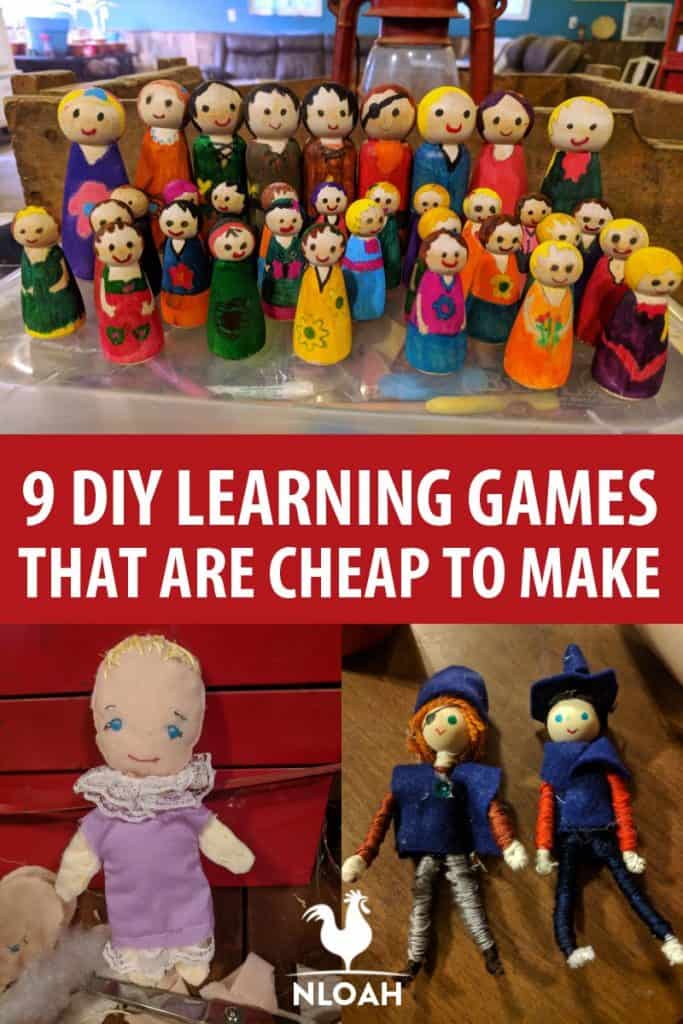

Tara lives on a 56 acres farm in the Appalachian Mountains, where she faces homesteading and farming challenges every single day, raising chickens, goats, horses, and tons of vegetables. She’s an expert in all sorts of homesteading skills such as hide tanning, doll making, tree tapping, and many more.

Made a snow globe with my granddaughter,.
1jar.
2 mini barbie figurines.
Assorted glitter
Super glue/or other waterproof adhesive
Glue figurines to lid, let dry.
Fill jar with water and add glitter.
Glue on lid, let dry.
Boom done.
She had the greatest time.